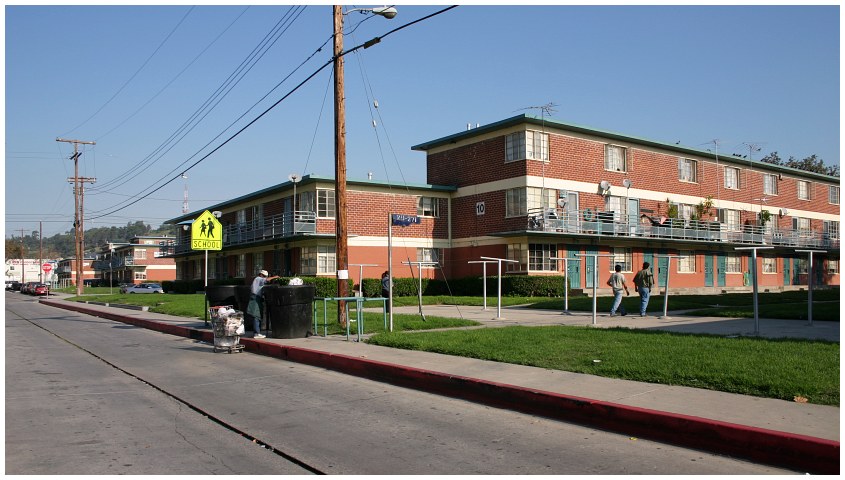
Santa Monica. (Photo: SantaMonica.gov)
Santa Monica Homeless Housing: $1 Million Per Apartment
You can keep getting wasted and not necessarily have to pay much if any rent
By Thomas Buckley, April 24, 2024 4:00 pm
One million dollars.
Well, technically $1,008,944.89 is what a new combination low and moderate income/permanent supportive housing for the homeless project in Santa Monica will cost per unit.
That works out to be $1,252 per square foot, at least double if not triple the going rate, industry experts say, to build apartment buildings in the Los Angeles area.
True, if you factor in the cost for the 19,000-square foot grocery store planned for the ground floor that drops the per-square-foot price to a bit over a $1,000 but that is still far far more than a private project would cost.
Oh, and the land is city owned so it was free, meaning no need to figure that into the projected cost.
And what does Santa Monica – the city council approved the project and an associated $2 million expenditure (the rest will come from grants and selling tax credits and such) on April 10 – get for its $123 million or so?
122 units, plus the aforementioned store, and about 100 below-ground parking spots, half for the store and half for the residents.
And it will take about six years to finish.
There will be 44 studio apartments of about 378 square-feet each – think an extended-stay hotel room with the kitchenette, etc. – 15 one bedrooms at about 650 square-feet, 39 two-bedrooms at about 900 square-feet, and 32 1,100 square-foot three bedroom units.
Most of the units will be set aside for low/mod rentals. For those, the rent is based on a sliding scale depending on the type of unit and the person’s income – it should be about 30% of income and that includes utilities and such.
But for the “permanent supportive housing” (PSH) units – of which there will be 50 (presumably most if not all of the studios and the rest one bedrooms) – the rent, according to The People Concern (TPC), the non-profit that will be providing said services, will be 30% of whatever income a person has coming in (up to limit, one presumes) wherever it comes from.
In other words, you pay part of what you have, or say you have, and could theoretically pay zero.
The project is being built by EAH Housing, which has a long history in developing and managing low/mod and PSH units. At the council meeting, according to the Santa Monica Lookout , Welton Jordan from EAH Housing, attributed the six year time frame – which was noted with chagrin by a pair of council members – to the complex financing and approval process. EAH currently has ten new housing developments under construction, and Jordan told the council, “So we’ve done this a lot. It’s very expensive to build buildings.”
Not that expensive, Mr. Jordan.
In breaking down the costs, about $76 million goes for actual construction, or “hard” costs., about $12 million for architecture and engineering, about $14 million for interest and fees and bond issuance, and another $20 million for what are termed “soft costs.” Quite often, soft costs includes design and financing, so it is unclear exactly what EAH defines as soft costs and why the percentage – 19% of the project – is so high compared to private development.
While EAH will develop the property, TPC – which will be getting paid by the county – will provide the services to the residents, both the formerly homeless and the others.
TPC is a firm believer in the idea of “housing first,” i.e. that you get a homeless person a guaranteed place to live first and then work on the other issues they may face, like addiction and mental illness.
“Adhering to the Housing First model, our staff work collaboratively across programs and departments to identify “best-fit” housing that will meet the specific needs of each individual,” states TPC on its website. “Housing First is an evidence-based practice to ending homelessness that prioritizes providing housing to individuals experiencing homelessness as quickly as possible without preconditions.”
In other words, the project will almost certainly be what is referred to as a “wet” house, or a place where a person can continue to use whatever substance they prefer and not have to worry about getting kicked out.
TPC says that 93% of the people it has worked with in PSH settings “never experience homelessness again.”
That sounds impressive but is actually unsurprising considering you can keep getting wasted and not necessarily have to pay much if any rent for a long time, if not forever (sounds like a good deal to me….)
Comparing the costs to other options and other types of construction and units is also eye opening.
In real estate there is something called “the 1% rule.” This is a rough guide for investing in rental property: you need to get 1% of the cost of the project to make it pencil. In this case, the rule would mean each unit would have to be rented for about $10,000 a month (1% of a million dollars.)
For $10,000 a month, one can rent a very nice place, even in Santa Monica.
While that may not exactly apply here, another comparison may be apt. Using Zillow you will find nice studio units in Santa Monica going for between $2,500 and $4,500 per month. Using this as a rough guide, each homeless person living at the project – currently a parking structure located at 1318 Fourth Street in downtown, about four blocks from the beach – will be receiving the equivalent of about $40,000 per year in free and/or reduced rent.
If one assumes the person has Medi-Cal, gets food stamps, and some other assistance, the value received jumps up to about $60,000 per year, not included the value of having your support staff live in the building with you.
Finally, also using Zillow, one will discover that many many small apartment buildings – maybe not as nice as this project, but still – are available throughout the region. The units average about $250,000 each or so, so buying say 10 or 15 buildings to provide the same number of housing units would cost about $30 million.
Neither the city nor TPC responded to requests for comment.
It should be noted that other PSH projects around Los Angeles County have been coming in at only about $850,000 per unit.
Well, it is Santa Monica.





As Mr. Buckeley pointed out, since the project will be a “wet” house, addicts can keep getting wasted and not necessarily have to pay much if any rent for a long time, if not forever.
Siyamak Khorrami from California Insider did an interview that’s on YouTube about how the City of Santa Monica has been impacted by homelessness, drug addiction, and drug overdoses. Santa Monica is actually the third busiest hub in all of LA County for overdoses was the first open-air needle distribution in the country. There are an average of 6000 to 7000 transit addicts coming through Santa Monica every year, with 2000 remaining at any given time. 95% are from out of state according to John Alley, a real estate expert and co-founder of the Santa Monica Coalition (https://thesantamonicacoalition.org).
If you build, they will come?
(https://californiainsider.com/california-news/videos/california-insider-show/santa-monica-residents-demand-safety-attention-as-homeless-population-increase-john-alle-5627379)
This is great TJ, so glad you posted this stuff.
What an utterly disgusting and wasteful mess, and a thoroughly unhelpful one, too, in that NO ONE who is fake-helped here is ACTUALLY helped by this insane “housing first” con job —- well except for the developer and the phony “wrap-around services” provider and the rest of ’em, who will all make out like bandits. In fact by being out of sight and out of mind the homeless/vagrants would fare better staying put in their darn tents and otherwise out in the open. It’s worse than unhelpful, it’s positively destructive. And soooooo expensive! How convenient for the “noble helpers”!
Is there anyone left who doubts there is a huge, thriving, and continuously growing Homeless Industrial Complex at work here?
Great points!
“Supportive housing” means hiring five social workers per vagrant for 24 hour shift – assume these are fully benefited SEIU members?
Work camps – put them all in work camps. Just like we did for GI’s in WWII. Good enough for them, it is more than good for these professional grifters. No work, no benefits. Their call.
And it provides good union jobs- as Biden says…of course, that’s also why the price is so high. With a store downstairs, the druggies can shoplift real close to home. What a genius project!
But if some working people are renting there at the market rate, and are trying to raise children next to thieves and drug users, they just might have a few complaints.
“With a store downstairs, the druggies can shoplift real close to home. What a genius project!”
Love this comment! 🙂
Me too 🙂
As a construction pro I find the 6 year schedule preposterous. I doubt this project would have taken more than 2 years if the parties involved actually wanted the job done and done right. There is only one reason to drag out the schedule like this and that is corruption.
Based on what I’ve seen, they could have this built in six months in Las Vegas.
I’m going to start doing drugs, get a pit bull, and move into one of those nice Santa Monica permanent housing units. I’ve always wanted to live by the ocean….for free.
Haha! LOL. You’ll fit right in, be the dude of the brood.
As a Santa Monica native of many decades this story should be a warning to the rest of the country… literally the canary in the coal mine. Santa Monica has skewed very Leftist for 4+ decades. The city spends millions on dollars every year on homeless and has more homeless than all the other beach cities combined. The tax paying citizens and visitors have to put up with drug addled insane vagrants. and their trails of feces and needles but the city council couldn’t care less. Virtue signaling children. Nothing will change until a council member or their family member is killed…
And in spite of all that I understand Santa Monica is STILL an ultra-expensive city to live in.
I worked there in the 80s, when the coastline was already crawling with menacing vagrants who brazenly held beach-adjacent parking spaces hostage — (pay up or, either way, who knows what will happen to you) —- but don’t visit nowadays for obvious reasons.
Brad Maaske, a real estate broker in Visalia, has a podcast and radio program. Today he told about this project, then related what happened in Tulare County when the county bought a motel to house the homeless. In 6 months it was trashed and had to be torn down. I’m sure that those units didn’t cost a million dollars, so imagine what the taxpayers will lose when the same happens to this project! And who in their right mind wants to live in close proximity to the homeless? http://www.realtalkbrad.com
You’re right, Pat, which leads to more money injections and more union hires and more growth of the Homeless Industrial Complex, which the participants see as a “win” and a “plus” —- unlike the average taxpayer or concerned-with-crime-and-filth-and-everything-else resident.
“The Homeless Industrial Complex” – Edward Ring, May 28, 2019
https://californiaglobe.com/fr/the-homeless-industrial-complex/